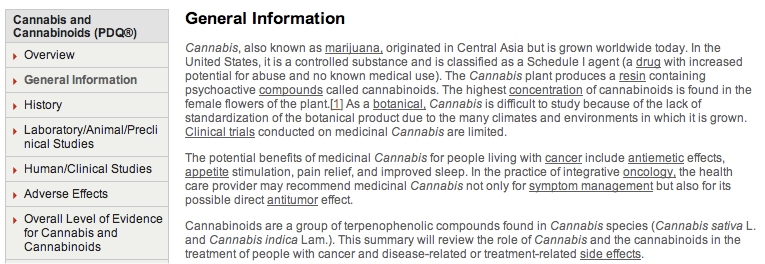Lähde: NORML Blog 30.3.2011
TuSKY uutisoi monien muiden kannabissivustojen tapaan USA:n syöpäinstituutin, NCI:n, kotisivuilla 17.3. julkaistua tietopakettia, jossa kerrottiin kannabiksen syöpäkasvaimia parantavista vaikutuksista. Tuolloin julkaistun tekstin pääkohta kuului:
”Lääkekannabiksen hyödyt syöpää sairastaville ihmisille ovat muun muassa pahoinvoinnin ehkäiseminen, ruokahalun lisääminen, kivun lievitys ja unen laadun paraneminen. Syövän yhdistelmähoidossa hoitava henkilöstö voi suositella lääkekannabista oireiden lievittämiseen, mutta tämän lisäksi myös sen mahdollisen syöpäkasvainta tuhoavan vaikutuksen takia.”
28.3. kyseinen kohta muutettiin sivustolla muotoon:
”Lääkekannabiksen hyödyt syöpää sairastaville ihmisille ovat muun muassa pahoinvoinnin ehkäiseminen, ruokahalun lisääminen, kivun lievitys ja unen laadun paraneminen. Vaikka hoitokäytännöistä ei ole tehty pätevää tutkimusta, näyttää siltä, että syöpäpotilaita hoitavat ja lääkekannabista suosittelevat lääkärit suosittelevat sitä pääasiassa oireiden hoitamiseen.”

Päivitys (31.3.): NCI on julkaissut tiedotteen, jossa se yrittää perustella hoitotietokantaan pikaisesti tehtyjä muutoksia.
Muita kohtia lääkekannabiksesta NCI:n sivuilta:
4. Laboratory/Animal/Preclinical Studies: ”These plant-derived compounds may be referred to as phytocannabinoids. Although delta-9-tetrahydrocannabinol (THC) is the primary psychoactive ingredient, other known compounds with biologic activity are cannabinol, cannabidiol, cannabichromene, cannabigerol, tetrahydrocannabivarin, and delta-8-THC. Cannabidiol, in particular, is thought to have significant analgesic and anti-inflammatory activity without the psychoactive effect (high) of delta-9-THC.”
Anti-tumor effects: ”Cannabinoids may cause anti-tumor effects by various mechanisms, including induction of cell death, inhibition of cell growth, and inhibition of tumor angiogenesis (new blood vessel growth) and metastasis cannabinoids appear to kill tumor cells but do not affect their non-transformed counterparts and may even protect them from cell death.”
”These compounds have been shown to induce apoptosis (cancer cell death) in glioma cells in culture and induce regression of glioma tumors in mice and rats. Cannabinoids protect normal glial cells of astroglial and oligodendroglial lineages from apoptosis mediated by the CB1.”
”A hypothesis that phytocannabinoids and endocannabinoids may be useful in the prevention and treatment of colorectal cancer has been developed.”
”Another study has shown delta-9-THC is a potent and selective antiviral agent against Kaposi sarcoma-associated herpes virus (KSHV), also known as human herpes virus. The researchers concluded that additional studies on cannabinoids and herpes viruses are warranted, as they may lead to the development of drugs that inhibit the reactivation of these oncogenic viruses (viruses that cause cancer).”
Appetite stimulation: ”Many animal studies have previously demonstrated that delta-9-THC and other cannabinoids have a stimulatory effect on appetite and increase food intake. It is believed that the endogenous cannabinoid system may serve as as regulator of feeding behavior. The endogenous cannabinoid anandamide potently enhances appetite in mice. Moreover, CB1 receptors in the hypothalamus may be involved in the motivational or reward aspects of eating.”
Analgesia (pain control): ”Understanding the mechanism of cannabinoid-induced analgesia has been increased through the study of cannabinoid receptors, endocannabinoids, and synthetic agonists and antagonists. The CB1 receptor is found in both the central nervous system (CNS) and in peripheral nerve terminals. Similar to opioid receptors, increased levels of the CB1 receptor are found in sections of the brain that regulate nociceptive (pain) processing.”
”Cannabinoids may also contribute to pain modulation through an anti-inflammatory mechanism; a CB2 effect with cannabinoids acting on mast cell receptors to attenuate the release of inflammatory agents, such as histamine and serotonin and on keratinocytes to enhance the release of analgesic opioids has been described.”
5. Adverse effects: ”Cannabinoids have a favorable drug safety profile. Unlike opioid receptors, cannabinoid receptors are not located in the brainstem areas controlling respiration; therefore, lethal overdoses due to respiratory suppression do not occur.”
”Although cannabinoids are considered by some to be addictive drugs, their addictive potential is considerably lower than that of other prescribed agents or substances of abuse.”
”Withdrawal symptoms such as irritability, insomnia with sleep EEG disturbance, restlessness, hot flashes, and rarely, nausea and cramping have been observed, but these symptoms appear to be mild compared with withdrawal symptoms associated with opiates or benzodiazepines, and the symptoms usually dissipate after a few days.”
”In clinical trials of cannabis, euphoria is often scored as an adverse effect.”
”In a retrospective cohort study of 64,855 men aged 15 to 49 years, participants were divided into cohorts (groups) based on their use of tobacco and marijuana never inhaled either, inhaled only cannabis, inhaled only tobacco, and inhaled tobacco and cannabis. Among the nonsmokers, two cases of lung cancer were diagnosed during the follow-up period. Among the men who inhaled tobacco either alone or in addition to marijuana, the risk of lung cancer increased tenfold. In the follow-up of men who inhaled marijuana alone, no cases of lung cancer were documented.”
”A case-controlled study of 611 lung cancer patients revealed that chronic low cannabis exposure was not associated with an increased risk of lung cancer or other upper aerodigestive cancers. A standardized questionnaire used during face-to-face interviews collected information on marijuana use expressed in joint-years, where one joint-year is the equivalent of inhaling one marijuana cigarette per day for one year. The results showed that, although using marijuana for 30 years or longer was positively associated in the crude analysis with each cancer type studied except pharyngeal cancer, no positive associations were found when adjusting for several cofounders including cigarette smoking.”
”Furthermore, a systematic review assessing 19 studies that evaluated pre-malignant or malignant lung lesions in persons 18 years or older who inhaled marijuana concluded that observational studies failed to demonstrate any statistically significant associations between marijuana inhaling and lung cancer after adjusting for tobacco use.”




